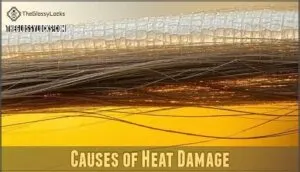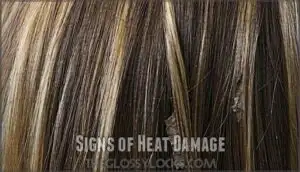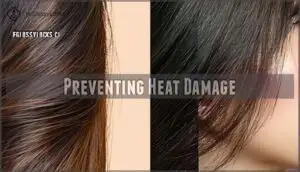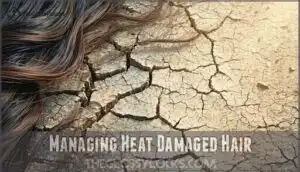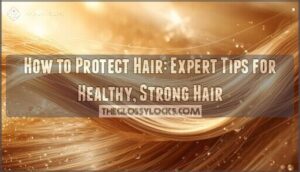This site is supported by our readers. We may earn a commission, at no cost to you, if you purchase through links.
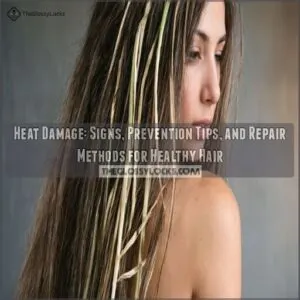
You’ll notice signs like dry, brittle strands, split ends, or a rough texture that feels like straw. High temperatures also zap your hair’s natural moisture, leaving it more prone to breakage.
Preventing heat damage is all about protection—use heat protectant sprays, keep tools at lower settings, and limit styling frequency.
If the damage is done, deep conditioners and protein treatments can help repair it. Sometimes, though, a trim is the best way to say goodbye to crispy ends.
Table Of Contents
Key Takeaways
- Protect your hair by using heat protectants, keeping tool settings below 350°F, and limiting styling frequency to reduce damage.
- Restore damaged hair with deep-conditioning masks, protein treatments, and regular trims to improve strength and moisture.
- Avoid habits that worsen heat damage like prolonged air drying, sun exposure, or using high-heat settings on styling tools.
- Opt for gentle brushes, nourishing products, and a healthy diet to support recovery and maintain moisture and elasticity.
Causes of Heat Damage
When you expose your hair to high temperatures, it weakens the proteins and strips away natural moisture. This combination breaks the hair’s structure, leaving it vulnerable to damage.
High temperatures weaken hair proteins and strip moisture, breaking its structure and leaving strands fragile and prone to damage.
High Temperature Effects
High temperatures wreak havoc on hair by causing keratin denaturation, leaving strands weak and prone to breakage.
Overexposure leads to irreversible changes as chromophore breakdown alters color, while tryptophan degradation causes discoloration.
Specifically:
- Cuticle damage exposes inner layers, increasing vulnerability.
- Hair proteins lose elasticity, reducing strength.
- Hair shafts suffer structural weakening, amplifying thermal damage risks.
Moisture Loss Mechanisms
When heat styling strips natural oils and evaporates water, your hair becomes vulnerable.
Heat styling zaps natural oils and moisture, leaving your hair brittle, vulnerable, and craving hydration to restore its strength and shine.
This process, known as cuticle disruption, breaks key hydrogen bonds, causing water evaporation and exposing the cortex.
As moisture escapes, hair turns brittle, prone to breakage, and feels like straw.
To fix dry hair, focus on repairing hair moisture with targeted hair damage repair techniques.
To mitigate this, consider using high-quality heat protectant to help restore your hair’s natural health and prevent further heat damage.
Protein Denaturation Process
When hair faces extreme heat, keratin proteins undergo denaturation, permanently altering their structure.
Tryptophan degradation and bond disruption weaken the cortex, leading to irreversible damage.
Thermal damage breaks hydrogen bonds, leaving hair brittle and lifeless.
This process makes the protein structure collapse, reducing elasticity and strength, resulting in dryness, dullness, and brittleness over time.
Stay cautious!
Signs of Heat Damage
You can often spot heat damage by watching for split ends, dryness, or a rough, brittle texture.
These changes make your hair harder to style and can cause it to lose its natural elasticity or shine.
Split Ends Formation
Split ends reveal heat damage’s toll, as your hair’s tips fray and split apart due to lost hair elasticity.
Heat exposure weakens the cuticle, disrupting moisture retention and leading to hair breakage.
Split types vary, but they all harm hair health.
Prevention methods like lower heat settings and regular trims help manage damage while preserving hair strength.
Dryness and Brittleness
When heat damage strikes, hair often feels dry and brittle, losing its natural moisture retention and elasticity.
Moisture loss weakens strands, increasing porosity and breakage causes.
Without hydration, dry hair becomes prone to more hair breakage.
Signs like frizz and hair dryness make styling difficult, leaving your locks fragile and dull.
Protect strands to fight brittleness!
Rough Texture Development
As damaged hair loses moisture, rough texture develops, causing manageability issues.
Cuticle disruption makes strands prone to frizz increase and tangling problems.
Here’s what you might notice:
- Increased Porosity: Hair absorbs water unevenly, feeling gritty.
- Dryness: Lacks smoothness, appearing brittle.
- Frizzy Hair: Strands no longer lie flat.
- Styling Challenges: Tools fail to restore softness.
Color Fading and Brassiness
When strands endure thermal damage, hair color changes become unavoidable.
Heat degradation weakens chromophores, causing dullness, yellowing, or darkened tones.
Toner stripping often accelerates brassiness, especially in chemically treated hair.
Tryptophan impact fades vibrant hues, leaving you with uneven shades.
To combat this, use color-safe shampoo to maintain your hair’s vibrancy.
Avoid high temperatures during hair drying to reduce chemical degradation and protect against irreversible hair color shifts caused by heat damage.
Avoid high temperatures during hair drying to further ensure protection of your hair color.
Preventing Heat Damage
You can protect your hair from heat damage by using the right tools, techniques, and products.
Stick to lower temperatures, apply a heat protectant, and give your strands regular breaks from styling.
Heat Styling Guidelines
Start by limiting styling frequency to let your hair recover. Always use low tool temperature settings, keeping them below 350°F to prevent heat damage.
Dry hair correctly; air dry or use a dryer at least 15 cm away. Section your hair properly to avoid overheating one spot.
Combine these with heat protectant application for solid thermal protection. You can also create a shield using leave-in conditioners for thermal protection.
Protective Shield Application
Applying a heat protectant before styling is like arming your hair with a shield. Use products with proven ingredient efficacy, such as hydrolyzed wheat protein, for reliable thermal protection.
Proper application techniques matter—spread evenly, focusing on ends where damage hits hardest. Many users find that a quality spray is essential for maximum protection.
Product layering boosts shield longevity, ensuring your hair stays healthier no matter how creative your styling gets, with the right thermal protection and a good quality spray.
Temperature Control Methods
Maintain healthy hair by mastering temperature control. Avoid high settings on hair tools, and let your locks air dry partially before styling. Always keep tools at ideal temperatures, adjusting for your hair type.
Remember, tool distance matters—hold hair dryers 15–20 cm away. Shorter drying times reduce heat damage, boosting hair protection while preserving its natural beauty.
Using a temperature regulated device helps prevent overheating.
- **Keep temperature below 350°F for safety.
- **Hold tools farther to prevent overheating.
- **Partially air-dry before using heat.
- **Reduce drying time for less damage.
- **Allow tools to cool between uses.
Hair Care Product Selection
Selecting the right hair products changes everything.
Look for a heat protectant with hydrolyzed wheat protein or professional brands offering leave-in conditioners.
Lightweight hair serums and nourishing oils, like argan, seal in moisture.
Budget options often compete with high-end lines, while natural alternatives deliver gentler care.
Ingredient analysis guarantees safe choices, protecting strands and reducing damage from styling.
Repairing Heat Damaged Hair
Repairing heat-damaged hair starts with restoring moisture and rebuilding protein to strengthen weakened strands.
Simple steps like using deep-conditioning masks, leave-in treatments, and professional care can help improve your hair’s health over time, which is crucial for restoring its original strength and appearance.
Moisturizing Mask Treatments
Struggling with heat damage? Reach for a moisture mask packed with shea butter or coconut oil.
These deep-conditioning treatments drench your hair in hydration, restoring shine and softness.
For mega impact, try overnight masks or create DIY mask recipes using avocado or honey. Apply weekly, focusing on ends.
Hair mask products are available online. Moisturizing ingredients work wonders when heat’s left its mark!
Protein Repair Techniques
Rebuilding damaged hair starts with protein treatments. They restore keratin, strengthen protein bonds, and repair internal damage.
Incorporate these three techniques:
- Use products with amino acids and peptides to rebuild hair protein bonds.
- Apply deep-conditioning masks rich in keratin for targeted hair protein restoration.
- Regularly use bond-repair treatments to fix structural damage and improve elasticity.
Leave-in Conditioner Benefits
Leave-in conditioners pack powerful benefits for repairing heat damage.
They offer hydration boosts, enhance shine, and provide frizz control while protecting strands from further damage.
By smoothing the cuticle, leave-ins improve detangling power, making styling easier.
Check this breakdown of benefits:
| Benefit | Impact |
|---|---|
| Hydration Boost | Restores moisture |
| Damage Prevention | Shields against heat |
| Detangling Power | Eases combing |
| Shine Enhancement | Revives dull strands |
These hair care treatments are a must for heat-damaged hair.
Salon Treatment Options
A salon visit can work wonders for heat-damaged hair.
Treatments like Deep Conditioning and Professional Hydration repair moisture loss, while Keratin Treatments and Olaplex Benefits strengthen strands through hair bond restoration.
Scalp Rejuvenation promotes overall health, and advanced hair damage repair techniques can target severe issues.
Trust salon experts for personalized hair treatments to aid long-term restoration, using techniques like Keratin Treatments.
Managing Heat Damaged Hair
Managing heat damaged hair requires a balance between proper care and thoughtful styling choices.
By adopting a consistent routine with moisturizing products, avoiding excessive heat, and regularly trimming damaged ends, you can protect the health of your hair, which involves making deliberate choices to preserve the integrity of your hair.
Home Care Routine
Caring for damaged hair at home starts with hydration habits.
Use a gentle shampoo, focus on scalp health, and avoid daily washes.
After washing, apply a nourishing hair mask or oil for moisture.
Practice gentle detangling to prevent breakage, and use DIY remedies sparingly.
At night, secure your strands with a satin bonnet or pillowcase for protection.
Hair Cutting Strategies
Trimming your hair regularly helps remove damaged ends, improving overall health.
A good haircut minimizes hair brittleness and prevents further hair damage. Deep conditioning masks restore moisture balance.
Explore professional trimming or these strategies:
- Layering Strategies: Reduce weight, enhancing bounce.
- Preventative Cuts: Keep split ends at bay.
- Micro-trims: Just the tips!
- Cutting Techniques: Choose blunt cuts for thicker strands.
- Focus on Damaged Ends: Target visibly frayed areas.
Styling Product Recommendations
Healthy styling starts with heat protectants for hair heat protection.
Add serum benefits and lightweight oil treatments to lock in moisture.
Cream stylers and mousse options enhance shape without heat stress.
A leave-in conditioner rebuilds strength while hair oil smooths flyaways.
These hair styling products guarantee effective heat defense, keeping damaged strands manageable and your styles looking their best.
Regular Trimming Importance
A regular hair cut works wonders for damaged hair, keeping it healthy by removing damage and preventing split-ends from traveling up.
Trimming frequency depends on your hair growth cycle, but every 6-8 weeks is a safe bet.
These small snips maintain shape, boost hair damage prevention, and guarantee hair care tips lead to long-term hair maintenance success.
Frequently Asked Questions (FAQs)
How long does heat damage take to go away?
Imagine your hair feels like straw after a curling session.
Heat damage doesn’t vanish overnight—it takes months.
Healthy growth, conditioning, and trimming split ends gradually restore strength, but complete recovery requires time and patience.
Can air drying also cause damage over time?
Air drying can cause damage if your hair stays wet for too long.
Prolonged moisture creates swelling in hair strands, weakening the structure over time.
To avoid this, gently towel-dry and use lightweight products.
How does humidity interact with heat-damaged hair?
Humidity worsens heat damage by pulling extra moisture into already weakened strands, making them frizz and lose shape.
It’s like your hair’s fighting a battle it’s not equipped to win—dry, brittle, and frazzled.
Are certain hairbrush materials better for damaged hair?
For damaged hair, brushes with soft boar bristles or wide-toothed wooden combs are ideal.
They’re gentle, reduce breakage, and help distribute natural oils, leaving your hair smoother without snagging or pulling.
What role does diet play in hair recovery?
Your diet impacts hair recovery by fueling growth and repair.
Nutrients like protein, biotin, zinc, and omega-3s strengthen strands, while vitamins A, C, D, and E promote scalp health.
Stay hydrated for ideal results, ensuring that your body has the necessary components to support hair recovery.
How does sun exposure impact hair with heat damage?
Sun exposure weakens hair further, especially if it’s already heat-damaged.
UV rays strip moisture, increase brittleness, and fade color.
To protect, use leave-in conditioners with UV filters, wear hats, or avoid peak sunlight hours, and prevent further damage by using leave-in conditioners.
Conclusion
Protecting your hair, preventing damage, and repairing existing heat damage requires mindful care and consistent effort.
Use lower heat settings, apply heat protectants, and limit your styling to maintain strong, healthy strands.
If your hair’s already showing signs like rough texture or breakage, try deep conditioners and protein treatments to restore moisture and strength.
When needed, trims can help you say goodbye to damaged ends, and with the right approach, your hair can stay resilient and beautiful.
- https://www.techradar.com/how-to/what-causes-heat-damage-to-hair-and-why-you-should-care
- https://www.realsimple.com/beauty-fashion/hair/heatless-hairstyles
- https://pubmed.ncbi.nlm.nih.gov/18408872/
- https://scholar.google.com/scholar_lookup?journal=J%20Cosmet%20Sci&title=Comparison%20of%20hair%20shaft%20damage%20after%20UVA%20and%20UVB%20irradiation&author=SY%20Jeon&author=LQ%20Pi&author=WS%20Lee&volume=59&publication_year=2008&pages=151-156&pmid=18408872&
- https://doi.org/10.1046/j.1467-2494.1998.177060.x

